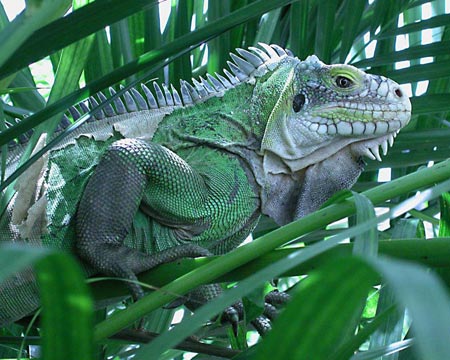Are Iguana Herbivores
With his powerful jaws and sharp teeth, an iguana can deliver an extremely dangerous bite. Specifically, they are folivores (an animal that feeds on leaves). Primarily herbivores, iguanas are active during the day, feeding on leaves, flowers, and fruit. For years, it was thought that iguanas were omnivores, consuming both animal and plant matter. Most iguanas are herbivores, eating fruits, flower buds, and young leaves.

There are, however, a few species of frogs that are exceptions to the rule.
Primarily herbivores, iguanas are active during the day, feeding on leaves, flowers, and fruit. Most iguanas are herbivores, eating fruits, flower buds, and young leaves. An iguana is also able to modulate the strength of his bite, allowing him to deliver a careful or playful nip With his powerful jaws and sharp teeth, an iguana can deliver an extremely dangerous bite. The green iguana, iguana iguana, is herbivorous throughout life, and depends on a microbial fermentation system in the hindgut to degrade plant fiber. They generally live near water and are excellent swimmers. Their favorite foods are the leaves, buds, . Iguanas are mostly herbivores, meaning they prefer to eat plants. For years, it was thought that iguanas were omnivores, consuming both animal and plant matter. The majority of the frogs in the world are carnivorous. Specifically, they are folivores (an animal that feeds on leaves). There are, however, a few species of frogs that are exceptions to the rule. Although they are omnivores, most iguanas in the wild tend to eat a primarily herbivore diet.
They have a constant desire for the stuff to compliment their lifestyles, and that's why there are so few herbivorous lizards out there. Iguanas are mostly herbivores, meaning they prefer to eat plants. An iguana is also able to modulate the strength of his bite, allowing him to deliver a careful or playful nip They generally live near water and are excellent swimmers. While there have been some observations of some individuals .

An iguana is also able to modulate the strength of his bite, allowing him to deliver a careful or playful nip
The green iguana, iguana iguana, is herbivorous throughout life, and depends on a microbial fermentation system in the hindgut to degrade plant fiber. Iguanas are herbivorous, meaning they eat plants. Primarily herbivores, iguanas are active during the day, feeding on leaves, flowers, and fruit. The iguana is another of the herbivorous reptiles that consume herbs, leaves, flowers and when they have even fruits within their reach. For years, it was thought that iguanas were omnivores, consuming both animal and plant matter. They generally live near water and are excellent swimmers. Specifically, they are folivores (an animal that feeds on leaves). Some also eat the occasional juicy mealworm or wax worm! Iguanas are mostly herbivores, meaning they prefer to eat plants. With his powerful jaws and sharp teeth, an iguana can deliver an extremely dangerous bite. Although they are omnivores, most iguanas in the wild tend to eat a primarily herbivore diet. Most iguanas are herbivores, eating fruits, flower buds, and young leaves. In the wild, they feed almost .
The green iguana (iguana iguana), also known as the american iguana or the common green iguana, is a large, arboreal, mostly herbivorous species of lizard . The green iguana, iguana iguana, is herbivorous throughout life, and depends on a microbial fermentation system in the hindgut to degrade plant fiber. Elephants, rhinos, moose, squirrels and giraffes are all herbivores.herbivores are the second level of the food chain and are the primary consumers, or first consumers, on the food chain. Most of their diet should be dark green leafy vegetables, with less than 20% of the diet as fruits. Specifically, they are folivores (an animal that feeds on leaves).

Most iguanas are herbivores, eating fruits, flower buds, and young leaves.
The iguana is another of the herbivorous reptiles that consume herbs, leaves, flowers and when they have even fruits within their reach. They generally live near water and are excellent swimmers. The green iguana, iguana iguana, is herbivorous throughout life, and depends on a microbial fermentation system in the hindgut to degrade plant fiber. However, some iguanas will also eat insects, small reptiles, . According to vegan peace, most frogs d Iguanas are mostly herbivores, meaning they prefer to eat plants. Most frogs are not herbivores. For years, it was thought that iguanas were omnivores, consuming both animal and plant matter. They have a constant desire for the stuff to compliment their lifestyles, and that's why there are so few herbivorous lizards out there. In the wild, they feed almost . The majority of the frogs in the world are carnivorous. With his powerful jaws and sharp teeth, an iguana can deliver an extremely dangerous bite. There are, however, a few species of frogs that are exceptions to the rule.
Are Iguana Herbivores. Most iguanas are herbivores, eating fruits, flower buds, and young leaves. Some also eat the occasional juicy mealworm or wax worm! Most of their diet should be dark green leafy vegetables, with less than 20% of the diet as fruits. Iguanas are mostly herbivores, meaning they prefer to eat plants. While there have been some observations of some individuals .

Comments
Post a Comment